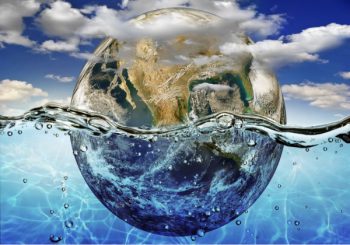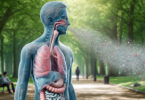By Ty Bollinger
Guest Writer for Wake Up World
Health experts say we should drink at least 64 ounces of water daily to replenish our bodies and maintain good health. This makes sense, because our body is made up of about 50-60% water by weight, although the exact amount can vary depending on several factors.
However, the importance of drinking enough water extends beyond simply avoiding dehydration. In fact, clean water can help detox our bodies and prevent disease, including cancer.
Simply put, water is our body’s filtration system, helping to flush out toxins.
Unfortunately, an estimated 70% to 80% of Americans are chronically dehydrated and miss out on the many powerful health benefits of water. Water performs many critical functions in the body, including:
- Serving as a carrier – in the form of blood, saliva, and other fluids – for oxygen, carbon dioxide, and many other nutrients
- Helping to maintain the structural integrity of our cells and tissues
- Aiding healthy digestion by helping to move food through the gastrointestinal tract and flushing out food waste and toxins
- Supporting an active, healthy metabolism
- Flushing waste and toxins as sweat and urine out of our body
- Maintaining proper membrane moisture levels
- Lubricating joints
- Helping to make hormones and neurotransmitters in our brain and body
- Controlling body temperature via sweating and respiration
Water and Cancer
Adequate fluid consumption has been associated with a lower risk of cancer formation in the bladder, colon, and breasts. An overview of multiple studies published in the Journal of Clinical Oncology shows that the more fluid a person consumes, the less likely it is that he or she will develop these potentially fatal cancers.
For instance, concentrated urine and less frequent urination exposes the inner wall of the bladder to higher levels of toxins for a longer time, increasing the risk of bladder cancer.
Similarly, water intake alone was seen to lower the risk of developing colon and colorectal cancer in both men and women in multiple studies. Based on the results of one animal study, the authors stated:
“This suggests that increased water intake may have an important role in reducing colon cancer risk by decreasing bowel transit time, reducing the mucosal contact with carcinogens, and decreasing the concentration of carcinogens.”
Another study established that drinking water is inversely and significantly associated with breast cancer risk.
In other words, maintaining optimal hydration is an essential tool for lowering our chances of getting cancer. And while these results are very promising, we have to remember that these studies likely took place in controlled laboratory conditions in which the quality of drinking water was carefully monitored.
What about us, the regular Joes and Janes? Is the water we drink and use just as safe and even beneficial for our health?
As it turns out, it isn’t.
According to the U.S.-based, non-profit international environmental advocacy group Natural Resources Defense Council (NRDC), more than 80,000 synthetic chemicals can be found in the air we breathe, food we consume, and water we drink – as well as in hundreds of everyday items such as furniture, carpets, household cleaners, cosmetics, and toys.
Unfortunately, most of these chemicals haven’t been sufficiently tested for their effects on our health, thanks to lack of adequate resources, outdated chemical safety laws, and loopholes that are being relentlessly exploited by the chemical industry.
Contamination of Our Water Supply
Few things connect us so directly to our natural environment as water – and the extent of its contamination is a direct reflection of the degree of contamination of our environment.
According to the U.S. Environmental Protection Agency (EPA), the U.S. enjoys one of the world’s most reliable and safest supplies of drinking water, thanks to the Safe Drinking Water Act (SDWA) passed by Congress in 1974 to protect public health.
Over 150,000 public water systems provide drinking water to most Americans. The SDWA requires the EPA to establish and enforce standards to which all public drinking water systems must adhere.
However, our water supply may not be as squeaky clean as the EPA would have us believe.
Rainwater dissolves compounds both natural and synthetic present in the air, then lands on the soil and runs into the many aquifers, streams, rivers, and lakes that supply our drinking water. Unfortunately for us, ground pollution finds its way into our water supply, with many potential points of entry before reaching our tap.
Specifically, the types and quantities of chemical pollutants in our water supply can result either from contamination of source water, as a consequence of treatment processes, or via entry into water distribution systems as it is conveyed to us.
Many synthetic compounds can potentially contaminate source waters, but these are usually present at fairly low to negligible levels and only affect us if they are toxic at low concentrations. On the other hand, chemicals that enter our water supply during the course of its treatment may be limited in number, but they are more likely to appear at higher levels and therefore pose a greater health risk.
Last but not least, contaminants present in the pipes, joints, and fixtures of our water distribution systems are likely to be highly pervasive and have the potential to cause widespread contamination, posing substantial health risks.
Currently, the EPA sets legal limits on over 90 contaminants in drinking water. These limits reflect the levels that are currently believed to protect human health and are achievable using the best available technology.
5 Contaminants in Source Water
Contaminants that enter our water supply from source water generally occur at low levels. Typical source-water contaminants include arsenic, asbestos, radon, agricultural chemicals, and hazardous waste.
1 | Arsenic – Some of the strongest evidence for a cancer risk associated with source-water contamination involves the highly toxic arsenic in drinking water. It is estimated that more than 150 million people globally are exposed to arsenic through ground water contamination. Arsenic is known to cause skin lesions and skin cancers. Although it doesn’t directly damage DNA, it disrupts many other aspects of DNA function, just like many known carcinogens do. Epidemiologic studies from Taiwan conducted in 1988 clearly showed that arsenic in drinking water is associated with a significantly higher risk of developing liver, lung, bladder, and kidney cancer.
2 | Asbestos – Although early studies indicated a risk of developing colorectal cancer associated with asbestos in drinking water, this was seen to be limited to situations in which naturally occurring levels of asbestos were high in source water. However, more recent evidence suggests that asbestos fibers in drinking water can raise the risk of stomach and colorectal cancers.
3 | Radon – This toxin causes DNA and cellular damage and is the second leading cause of lung cancer deaths after tobacco smoke. Low levels of radon can be found in drinking water, which slightly increases indoor air levels. However, the risk of developing stomach and other gastrointestinal cancers from radon in drinking water is considered to be small.
4 | Agricultural chemicals – These can cause local or regional contamination of source waters because of the presence of significant levels of toxic insecticides, fungicides, rodenticides, herbicides, and fertilizers. Studies in China have shown that populations exposed to high nitrate levels in drinking water had a greater risk of developing stomach and liver cancer.
5 | Hazardous waste – Evidence has been found of elevated cancer rates in the vicinity of hazardous waste sites. However, it is difficult to estimate the exact cancer risks associated with hazardous wastes – each specific instance must be assessed on its own.
Water Disinfectants and Cancer
Disinfection of drinking water using chlorine was originally instrumental in lowering disease and death rates associated with many waterborne disease carriers. However, in the 1970s it was shown that chlorination leads to the production of halogenated organic compounds in water, particularly chloroform.
A meta-analysis which evaluated the association between consumption of chlorinated drinking water and cancer showed elevations in risk for almost every type of cancer, especially bladder and rectal cancer.
Byproducts of disinfection are formed when disinfectants such as chlorine, ozone, chlorine dioxide, and chloramines react with naturally occurring organic matter, contaminants, bromide, and iodide during the production of drinking water.
At the moment, 11 of these disinfection byproducts are currently regulated in the US, while the remaining 70+ are considered “emerging” byproducts due to their presumed lower levels of occurrence and less toxicity – and frankly, much less information about how they affect our health.
Alternative disinfection practices were originally intended to result in safer drinking water. However, it turns out that at least a few of the supposedly safer emerging byproducts are generated at higher levels and may be more damaging to our DNA and cells, relative to those produced by chlorination.
For instance, the byproducts of bromine compounds were shown to be both more damaging to DNA and carcinogenic than chlorinated compounds, while iodinated byproducts were the most damaging to DNA, although these have not yet been tested for their carcinogenicity.
To a certain extent, we now understand better how some – but by no means all – disinfection byproducts may be affecting our body. How they interact with each other and affect us in the combinations we are likely to encounter in our environment is not as clear.
Chloroform and Cancer
Among the many hazardous chemicals to which we’re exposed on a regular basis is chloroform – which typically enters our environment as a waste product from chemical companies and paper mills. It is also found in wastewater from sewage treatment plants and drinking water to which chlorine has been added.
Chloroform can enter the air directly, or by evaporating from water and soil that contain it – and while it dissolves easily in water, it does not stick to the soil very well. This means it can travel down through soil and enter the water supply, where it stays for a long time.
Most chloroform eventually breaks down, very slowly, into phosgene, which is even more toxic than chloroform, and hydrogen chloride, which is also toxic. There are probably small amounts of chloroform in our drinking water (as a byproduct of chlorination) and other beverages. Unfortunately, chloroform has been found in the air from all areas of the U.S. and in nearly all public drinking water supplies.
Chloroform easily enters our body through the skin, for example when taking a bath or shower in water containing chloroform, because hot water opens up our skin’s pores and removes skin oils, which would have otherwise helped to form a natural defensive barrier. Studies show that once it enters our body, chloroform quickly enters our bloodstream from the lungs or intestines. It is then carried by blood to all parts of the body, especially our fat stores, liver, and kidneys.
Some of the chloroform in our body is broken down into other chemicals known as breakdown products or metabolites, which themselves can cause adverse effects if they accumulate in high enough amounts.
In our body, chloroform adversely affects our central nervous system including the brain, liver, and kidneys. Breathing about 900 parts of chloroform in a million parts of air for a short time causes fatigue, dizziness, and headache.
Although no reproductive effects have so far been documented in people, in laboratory experiments, miscarriages occurred in rats and mice that breathed air containing high levels of chloroform during pregnancy.
Further, mice that breathed air containing elevated levels of chloroform developed abnormal sperm, while the offspring of rats and mice that breathed chloroform during pregnancy had birth defects.
Cancer of the liver and kidneys developed in rats and mice that ate food or drank water that had large amounts of chloroform in it for a long time.
Studies on people who drank chlorinated water showed a possible link between the presence of chloroform in chlorinated water and cancer of the colon and urinary bladder.
It is presently unclear whether liver and kidney cancer will necessarily develop in people after long-term exposure to chloroform in drinking water. However, based on animal studies alone, the Department of Health and Human Services (DHHS) has determined that chloroform may reasonably be anticipated to be a carcinogen.
Similarly, the International Agency for Research on Cancer (IARC) has determined that chloroform is possibly carcinogenic to humans, while the EPA has also determined that chloroform is a probable human carcinogen.
Can Plastic Containers Cause Cancer?
You may have heard by now how even “healthy” mineral water can be a significant hazard to your health, if it is stored in plastic containers and water bottles.
The source of this health hazard is Bisphenol A, or BPA, which is a key building block of all plastics, from polycarbonate to polyester. BPA is routinely used to line food cans to prevent corrosion and food contamination. It is also used to make plastic cups, baby bottles, and regular bottles transparent and shatterproof.
Unfortunately, BPA also leaches from plastics and resins when they are exposed to hard use, or the high temperatures typically seen in microwaves or dishwashers.
The FDA first approved BPA as a food container component in 1963 because no ill effects from its use had been shown. BPA slipped in under the regulatory radar, because when Congress passed the Toxic Substances Control Act in 1976, requiring that the EPA conduct or review safety studies on new chemicals, BPA was already on the market. Therefore, it was not subject to the new rules nor required to undergo additional testing, because specific concerns had not been raised.
One of the first clear indications of how pervasive BPA had become in our lives and environment came from an analysis carried out in 2004, when the U.S. Centers for Disease Control (CDC) found traces of BPA in nearly all of the urine samples it had collected to assess the prevalence of toxic chemicals in the human body.
Although, in this particular analysis, BPA levels were estimated to be 1,000 times lower than the limit considered safe by the EPA and the European Union’s European Food Safety Authority (EFSA), what was worrying was glucuronide – a waste product of BPA – was present in most of the urine samples analyzed, suggesting that we’re being exposed to it on a regular basis.
Also, children had higher levels of glucuronide than adolescents and adolescents had higher levels than adults – although adults cope with BPA better than children and infants. Unfortunately, it seems babies might be exposed the most, because both baby bottles and infant formula cans are likely to leach BPA.
A recent report in the journal Reproductive Toxicology suggests that the urine data may not be telling us the complete story. The authors of this report state that we are likely exposed to levels of BPA 10 times higher than what the EPA has deemed safe, based on the amounts of BPA and its breakdown products seen in tissue and blood samples.
So, what’s the problem with BPA exposure?
First of all, BPA mimics estrogens. In other words, it binds to the same receptor proteins in our body’s cells as the natural female hormones. As a consequence, BPA is likely to both interfere with hormonal pathways and mimic them, but imperfectly and incompletely, potentially leading to serious health problems.
Indeed, BPA has been shown to contribute to the development of several hormone-dependent cancers such as breast, ovarian, and prostate cancers by disrupting our hormonal pathways. Once it enters our body, BPA tends to build up, especially in the placenta and fetus. Scientific and medical evidence shows that BPA severely disrupts fetal development in the embryo, along with harming both the male and female reproductive systems.
Unfortunately, laboratory studies in animals show that BPA can have permanently damaging effects after even very short exposures.
BPA has also been shown to directly damage DNA. Even though the liver breaks BPA down efficiently, Bisphenol-o-quinone, one of the breakdown products, has also been shown to bind to DNA, potentially changing how DNA functions in our cells and perhaps even contributing to cancer formation.
BPA also interferes with multiple signaling pathways in our cells, again with potentially serious health consequences.
Of course, the plastics industry argues that BPA should continue to be used because of its many convenient features that they claim are hard to match. However, some experts feel that the much more stable polyethylene and polypropylene plastics would be perfectly acceptable substitutes, at least for some applications.
In Japan, manufacturers began using natural resin instead of BPA to line cans after their scientists showed that BPA was leaching out of baby bottles. In what seems to be a direct consequence of this measure, a 1999 study found that levels of BPA and its breakdown products in the urine of Japanese test populations had declined significantly.
For now, U.S. scientists recommend that anyone worried about BPA’s adverse health effects should simply avoid using products made from it: Polycarbonate plastic can be easily identified, being clear or colored and typically marked with a number 7 on the bottom.
If canned goods or polycarbonate plastic bottles cannot be avoided, they should never be microwaved, used to store heated liquids or foods, or washed in hot water, either by hand or in much hotter dishwashers. Finally, common sense dictates that they should be regularly recycled and replaced with new bottles, depending on how often they are being used.
4 Methods of Water Purification
According to a 2007 WHO report, more than a billion people lack access to safe drinking water. Reducing deaths from waterborne diseases is a major public health goal for many developing countries even today. Water purification is the process of removing undesirable chemicals, biological contaminants, suspended solids, and gasses from water to produce water fit for a specific purpose – for example, drinking.
Methods of water purification include physical processes such as filtration, sedimentation, distillation, and reverse osmosis; biological processes such as slow sand filters or biologically active carbon; chemical processes such as flocculation and chlorination, and the use of electromagnetic radiation and ultraviolet light.
Unfortunately, simple homegrown procedures such as boiling or using household activated carbon filters are no longer sufficient for removing all the possible contaminants likely to be present in our water supply. In fact, even so-called “natural spring water” is now routinely tested to determine if any pre-treatment is required to make it safe for drinking.
Let’s take a look at a few effective methods of water purification:
1 | Rapid sand filtration – In this approach, water moves vertically through many layers of sand, usually with a layer of activated carbon or anthracite coal above the sand that removes organic compounds that contribute to taste and odor.
Most of the contaminant particles pass through the surface layers but are trapped in pore spaces or adhere to sand particles. Effective filtration extends into the depth of the filter, since if the top layer of sand were to block all the particles, the filter would quickly clog. Some water treatment plants employ pressure filters, in which the filter medium is enclosed in a steel vessel and water is forced through it under pressure.
Rapid sand filtration filters are strong, filter out much smaller particles than other filters can, including virtually all particles larger than their specified pore sizes, enable liquids to flow through them fairly rapidly, and can be cleaned and reused.
2 | Slow sand filtration – On the other hand, slow sand filters are large-scale filters that rely on biological processes for their action. They are carefully constructed using graded layers of sand, with the coarsest sand, along with some gravel at the bottom, and finest sand at the top.
Slow sand filtration depends on the development of a thin biological layer, known as the zoogleal layer, on the surface layer of sand. A zoogleal layer is a complex population of living microorganisms that form a slime growth which breaks down organic matter. The filtered water that emerges at the bottom of a slow sand filter has very low nutrient and disinfectant levels.
Slow sand filters are maintained by having the top layer of sand scraped off when flow is eventually obstructed by excess biological growth.
3 | Reverse osmosis –This is a technology used to get rid of most contaminants from water by pushing the water under pressure through a semipermeable membrane.
A semipermeable membrane allows some atoms or molecules to pass through it but not others, for example dissolved salts, organic compounds, and bacteria, based on size differentiation.
Normally, water with fewer compounds and contaminants in it will tend to migrate towards water with more compounds, when separated by a semipermeable membrane – this is known as osmosis. Examples of osmosis are plant roots absorbing water from the soil and our kidneys absorbing water from our bloodstream.
While osmosis happens naturally, without any need for energy, to reverse the process of osmosis high pressure has to be applied to the water with more compounds in it. This reverses the flow of water, thereby desalinating, demineralizing, or deionizing it and allowing highly purified water through while holding back most of the dissolved compounds and contaminants.
In other words, the high pressure causes impurities to become more concentrated on one side of the semipermeable membrane.
4 | Ion exchange – This is a reversible chemical reaction in which positively or negatively charged molecules known as ions dissolved in a solution are removed and replaced with other, similarly charged ions.17 Ion exchange is used to purify, separate, and decontaminate solutions of water containing ions. For instance, ion exchange is typically used for softening water by removing calcium and magnesium ions.
Ion exchangers can either be cation exchangers, which exchange positively charged ions (cations), or anion exchangers, which exchange negatively charged ions (anions). There are also exchangers that are able to exchange both cations and anions simultaneously.
In a cation exchange process, positively charged ions in water are exchanged with positively charged ions, typically sodium. Water softening is the most widely used cation exchange process. Similarly, in anion exchange negatively charged ions are exchanged with negatively charged ions, typically chloride. Contaminants in water such as nitrate, fluoride, sulfate, and arsenic, as well as others, can all be removed by anion exchange.
Originally published at The Truth About Cancer and reproduced here with permission.
About the author:
 Ty Bollinger is a health freedom advocate, cancer researcher, former competitive bodybuilder and author. After losing several family members to cancer, he refused to accept the notion that chemotherapy, radiation, and surgery were the most effective treatments available for cancer patients. He began a quest to learn all he possibly could about alternative cancer treatments and the medical industry. What he uncovered was shocking. There is ample evidence to support the allegation that the “war on cancer” is largely a fraud and that multinational pharmaceutical companies are “running the show.” Ty has now made it his life mission to share the most remarkable discovery he made on his quest: the vast majority of all diseases, including cancer, can be easily prevented and even cured without drugs or surgery.
Ty Bollinger is a health freedom advocate, cancer researcher, former competitive bodybuilder and author. After losing several family members to cancer, he refused to accept the notion that chemotherapy, radiation, and surgery were the most effective treatments available for cancer patients. He began a quest to learn all he possibly could about alternative cancer treatments and the medical industry. What he uncovered was shocking. There is ample evidence to support the allegation that the “war on cancer” is largely a fraud and that multinational pharmaceutical companies are “running the show.” Ty has now made it his life mission to share the most remarkable discovery he made on his quest: the vast majority of all diseases, including cancer, can be easily prevented and even cured without drugs or surgery.
For more information, visit:

If you've found value in our articles, we invite you to support the release of our brand-new book, "Gratitude Practices for Kids: A Practical Guide for Adults to Instill a Spirit of Appreciation and Positivity in the Next Generation."
"Gratitude Practices for Kids" brings together over 25 innovative and accessible practices designed to enhance gratitude in everyday life. This comprehensive guide is backed by 17 scientific studies, ensuring each concept is grounded in research, underscoring our commitment to nurturing growth, emotional intelligence, and positive interactions between adults and children.
We encourage you to opt for the paperback version to celebrate this new release. Dive into its fresh pages away from digital distractions, allowing you to immerse yourself in the transformative practices it offers.
Over recent years, Wake Up World has faced significant online censorship, which has impacted our financial ability to operate. Moving into book publishing represents a strategic step to secure the ongoing funds needed to continue our mission. By purchasing Gratitude for Kids, you help us keep our content free and accessible to everyone, avoiding needing a paywall. With over 8,500 articles published in the last 13 years, we remain dedicated to keeping our valuable content open to all.








